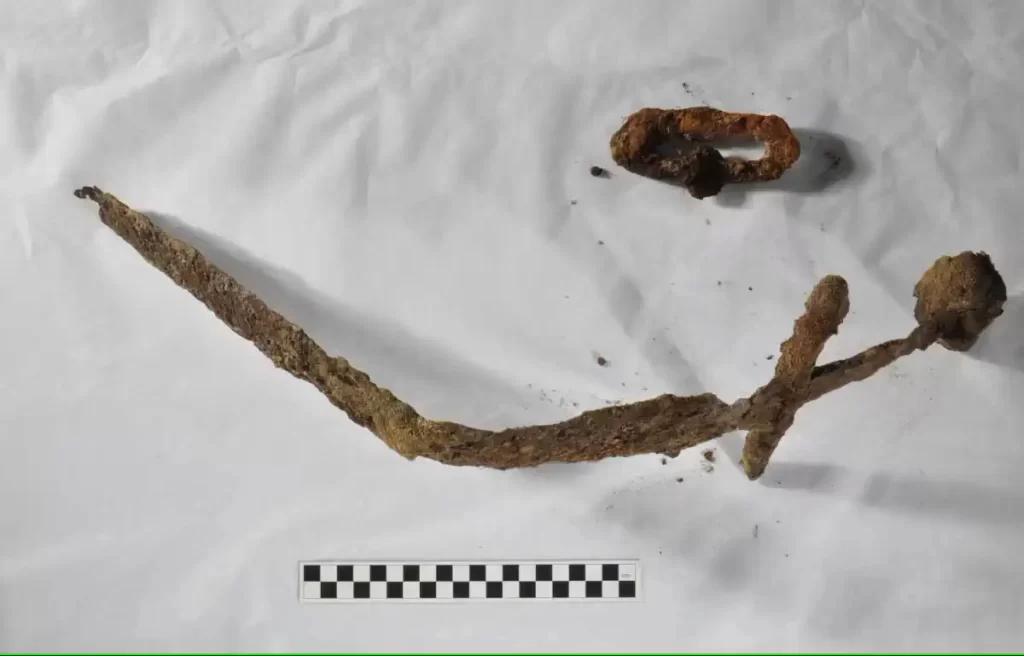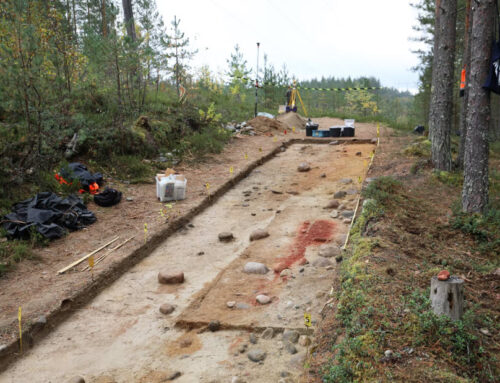Crusade period grave field discovered in Southwest Finland
A sword peeking out of the ground revealed a huge surprise in Salo – dozens, perhaps hundreds of graves likely from the 12th or 13th century.

A sword dated to the Crusade period in Finland led archaeologists to identify an extensive medieval cemetery. Image: Riikka Saarinen / Turun Museokeskus
Looking over excavation work for the installation of geothermal pipes, a landowner in the municipality of Salo noticed a piece of iron sticking out of a pile of dirt. Pulling it out, he found himself holding an almost complete Crusader sword.
The find has now led to the discovery of an extensive grave field, not far from the grey granite medieval church of Pertteli.
The landowner contacted Juha Ruohonen, an archeology instructor at the University of Turku, who says in a university press release that the sword is of the Crusader type typical of the period of 1050–1150. It has a bar-like, straight crossguard and a three-sided, oval pommel.
The Crusades in this context were a series of expeditions, traditionally regarded as starting in the 12th century and continuing until the end of the 13th century, during which the Swedish Crown and the Catholic Church extended and strengthened control over large parts of what is now Finland.
Field examination confirms grave site
Following the discovery of the sword, an archaeological survey of the area was carried out and the existence of a cemetery at the site was confirmed.
In early September, preliminary exploration by Ruohonen and a group of archaeology students of the University of Turku turned up a number of artifacts in the trenches excavated for the geothermal installation. They include parts of another sword, remains of wooden coffins and human bones.
Their most remarkable find, though, was the remains of a leather belt decorated with bronze ornaments.

One of the rosette-patterned bronze ornaments that decorated a belt found at the grave site. Image: Juha Ruohonen / Turun yliopisto
Thirty square bronze plaques decorated with rosette patterns had been attached to the belt, as well as several cross-shaped pendants.
“The whole belt also included a buckle, several end tips, animal-head decorations and strap dividers. The leather parts of the belt are partially preserved. In addition, the bronze ornaments still show plenty of fragments of attached fabric, remnants of the clothing of the deceased,” Ruohonen explains.
This is the first confirmed discovery of a grave field dating to the end of the Iron Age in the Salonjoki river valley, according to the University of Turku.
More likely to come
A more detailed examination of the site showed that archaeologists were looking at more than a single grave. Altogether, eight graves were discovered.
It is estimated that the site may contain dozens more burial sites, possibly as many as two hundred.
Ruohonen says that the discovery can be considered very significant from a research point of view, as far fewer cemeteries containing inhumations from the time of the Crusades are known in Finland than earlier Iron Age cremation grave sites. The deceased in this newly-discovered cemetery were buried in accordance with Christian customs.
“The location of the site, in the immediate vicinity of a medieval stone church, can be considered as evidence of a much earlier church organization in the area than previously believed. It has been thought that Pertteli parish was established with the founding of the Uskela chapel in the 15th century,” Ruohonen points out.
Radiocarbon dating is being carried out on the bone recovered from the site. The belt and a knife sheath are being x-rayed, further studied and conserved.
Research on the finds will continue at least until the beginning of 2024.
Source: YLE NEWS – 12.10.2023





